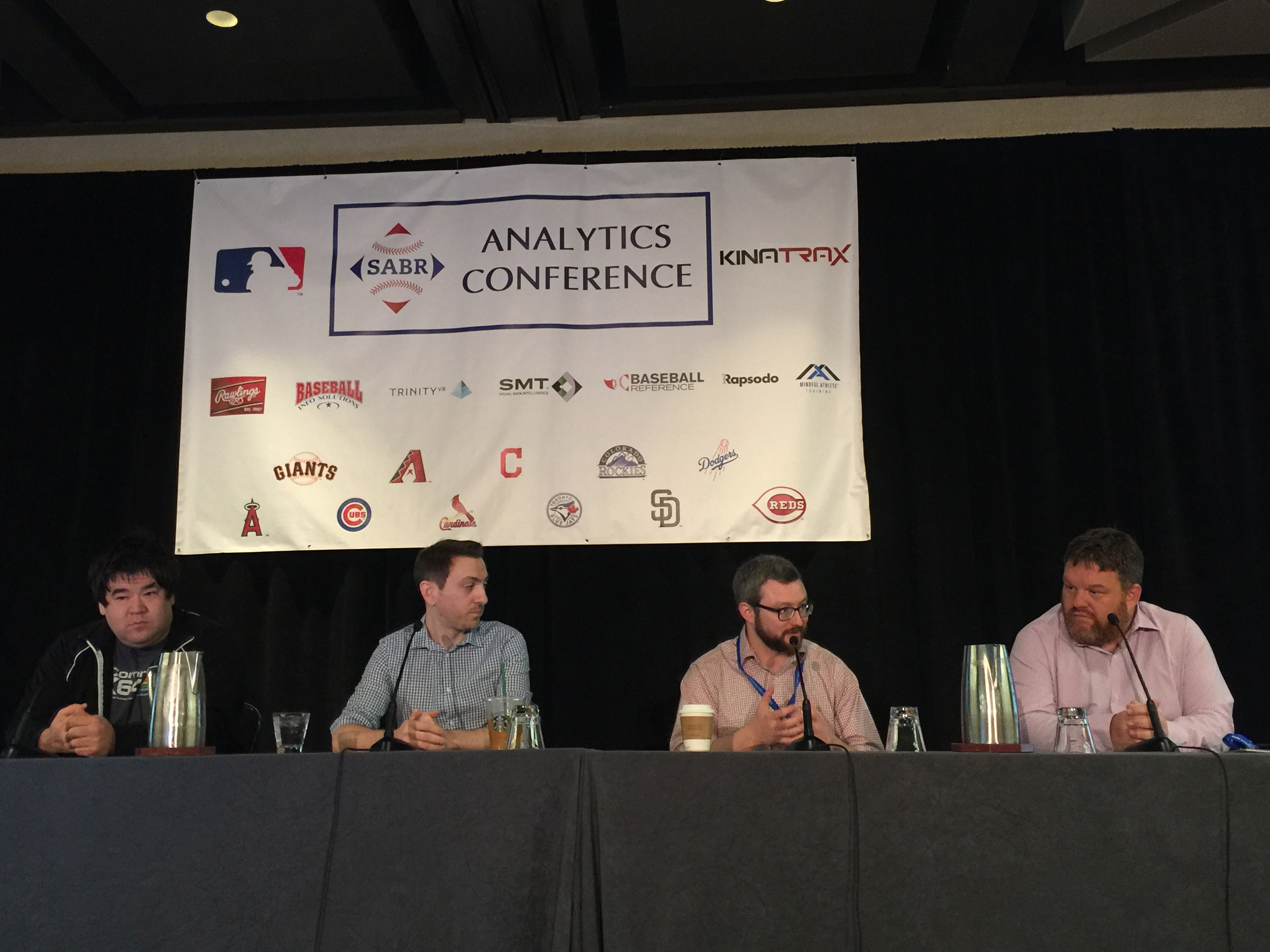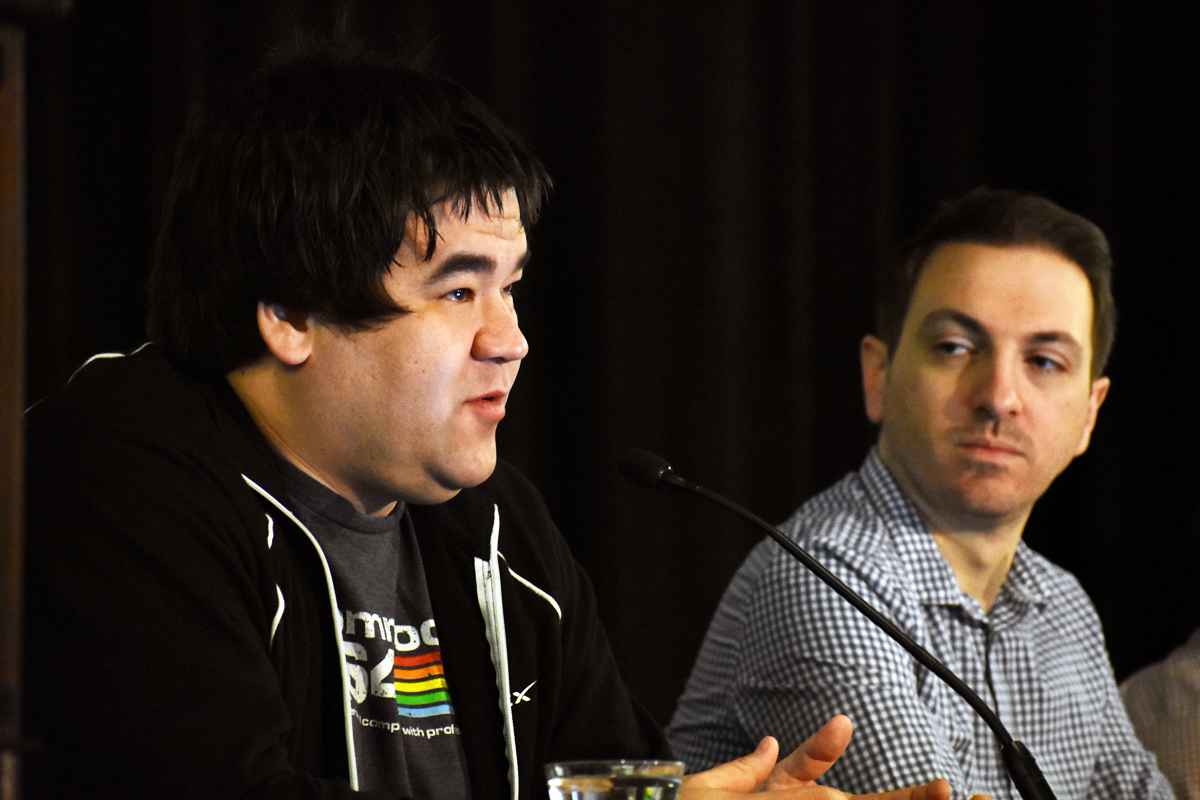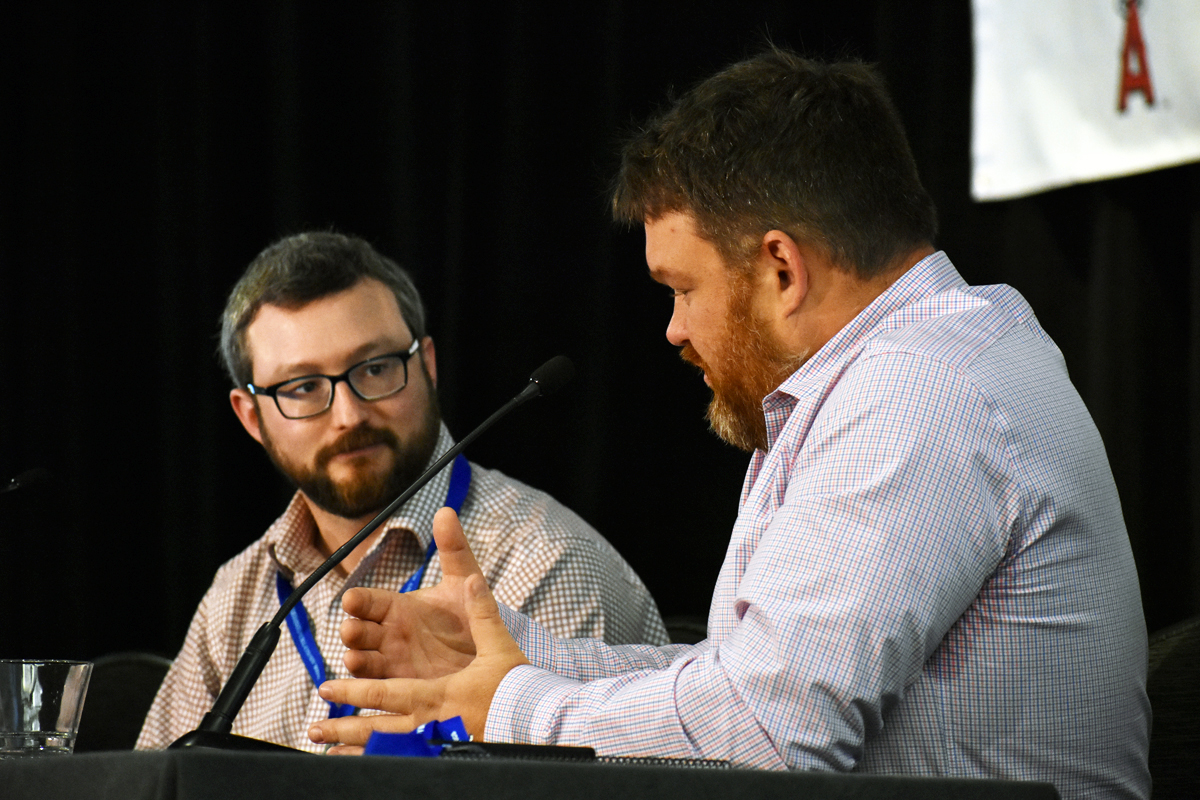2019 SABR Analytics: Listen to highlights from the Keeping Data Flowing panel
The Keeping Data Flowing panel at the 2019 SABR Analytics Conference, presented by MLB and KinaTrax, focused on how teams take information from their analytics departments to coaches and, ultimately, players.
The panel on March 9, 2019, featured Kyle Boddy, founder and owner of Driveline Baseball; Mike Petriello, stats analyst for Major League Baseball; and Joe Rosales, Vice President of Research and Development for Baseball Info Solutions. It was moderated by Mike Ferrin, Arizona Diamondbacks broadcaster and MLB Network Radio host.
- Audio: Listen to highlights from the Keeping Data Flowing panel at the 2019 SABR Analytics Conference (MP3; 1:01:39)
 Here are some highlights:
Here are some highlights:
ON COMMUNICATING DATA TO COACHES, EXECUTIVES, PLAYERS, AND FANS
- Rosales: “To a certain degree, we just have to try to build the best tools, the most digestible tools, the kind of things that are going to be easily presentable and easily understandable to the staff who aren’t necessarily going to be as familiar with these statistics and analytics. … The one thing that’s good is that as it becomes clear there’s more and more information out there, and more and more things to do with the analytics, if you’re not using them, you’re falling behind. The coaches themselves start getting curious. … [There have been instances where] we don’t have a direct line to the coach, but it’s clear that they’ve been using our data.”
- Boddy: “We can produce changes, whether it’s in fastball velocity or movement or spin, and then we can validate using actual sabermetrics to determine if that change is relevant or if we should care. … Andrew Friedman, when he was with the [Tampa Bay] Rays, told me that the best way to make an impact is to empower the players and have them bubble up through the systems because it’ll force the remainder of the organization to really care. Rather than a top-down approach, you have people organically adapting and adopting these technologies and demanding them at the highest level.”
- Petriello: “The hardest part of my job is knowing that I’m writing to an audience that still thinks RBIs are the coolest thing in the world, and a lot of players and coaches come from that background. … You can’t really go to a player and tell them they need to change their laminar flow. You have to approach it in a different way and say, ‘If you change this, we think your batting average against will drop by 20 points and maybe you’ll make $4 million more next year.’ … As more and more players buy into this, and gain success, now every team has five relievers who suddenly throw ridiculous sliders because they’ve learned how to use this information.”
 ON EMERGING BASEBALL TECHNOLOGIES
ON EMERGING BASEBALL TECHNOLOGIES
- Boddy: “Using technologies like Rapsodo or Edgertronic are just required. Like, that’s not getting ahead [anymore]. … This is the first year where it’s just normal [throughout the game.] It’s here, it’s not going away, and players and coaches are going to have to get used to it.”
ON RECONCILING ‘NEW AGE’ ANALYTICS WITH ‘OLD SCHOOL’ THOUGHT
- Petriello: “There’s not a one-size-fits-all way to do any of this. … A lot of this ‘new’ stuff has kind of proved the ‘old’ stuff. … It’s not about throwing out everything that used to be and saying ‘This is the right way,’ it’s about thinking about things in new ways. … [Sabermetrics] now isn’t about team building, because everyone can find good players. Now, it’s about improving players.”
- Rosales: “When you can show that we are considering the little things [like balls close to the outfield wall] that are intuitive to people in the baseball community that, ‘Yeah, it is being accounted for the fact that a guy can’t run to a ball at the wall the same way they can for a ball in open space,’ you can tie these concepts and show people video that make them aware [of the work we’re doing]…”
ON DATA-BASED DEVELOPMENT FOR RELUCTANT PLAYERS
- Boddy: “It’s important to realize that a player’s experiences are very real to them. … [Jon] Lester has accomplished a lot in his career so you can’t just tell him what the deal is. … I think the veteran players understand that delineation. We have to have that baseline respect for a player’s accomplishments, followed by trying to go into how we think a player can improve. … In reality, the times that a veteran who would normally be unreceptive to this information is when they’re struggling and have no other answers anymore. They’ve done everything the coaches tell them and they’re not getting better and they’re wondering ‘Why is that the case?’ You just have to have that respect and understanding of humanity and not force it on them until they’re ready to hear it.”
- Rosales: “You have to remember that the ultimate analytical tool is the human brain. … Just because someone isn’t necessarily using numbers to make a decision doesn’t mean they’re not making the right decision. … Obviously, the human brain is fallible, but it’s not impossible that there are certain players where their ‘feel’ really just means that they’re processing information in an analytical way that allows them to be successful.”
 ON THE FUTURE OF DATA-BASED SABERMETRICS AND DEVELOPMENT
ON THE FUTURE OF DATA-BASED SABERMETRICS AND DEVELOPMENT
- Petriello: “It has to be injury prevention. … Tommy Johns are down, so maybe we’re making some progress there, but it’s not something I’m aware of anyone being close to doing. We found the good players, we’re improving them, now we have to keep them healthy.”
- Boddy: “I would challenge the idea that we’ve found all the good players. There’s no way that baseball pitchers are the best throwers of objects on this planet. It’s not true. There’s javelin athletes, there are elite cross-sport athletes that we could attract more to baseball. … Initiatives in baseball recruitment that I’ve been involved with in Europe has shown this. MLB is starting to make in-roads in non-Latin American countries. … Why can’t baseball attract, say, German handball athletes? They’re 6-foot-8, 250 pounds, and incredibly fast, and they make nothing! Those are great areas where I think we can do some nontraditional scouting, and I think it’s starting to be uncovered by teams.”
For more coverage of the 2019 SABR Analytics Conference, visit SABR.org/analytics.
Originally published: March 13, 2019. Last Updated: July 27, 2020.


